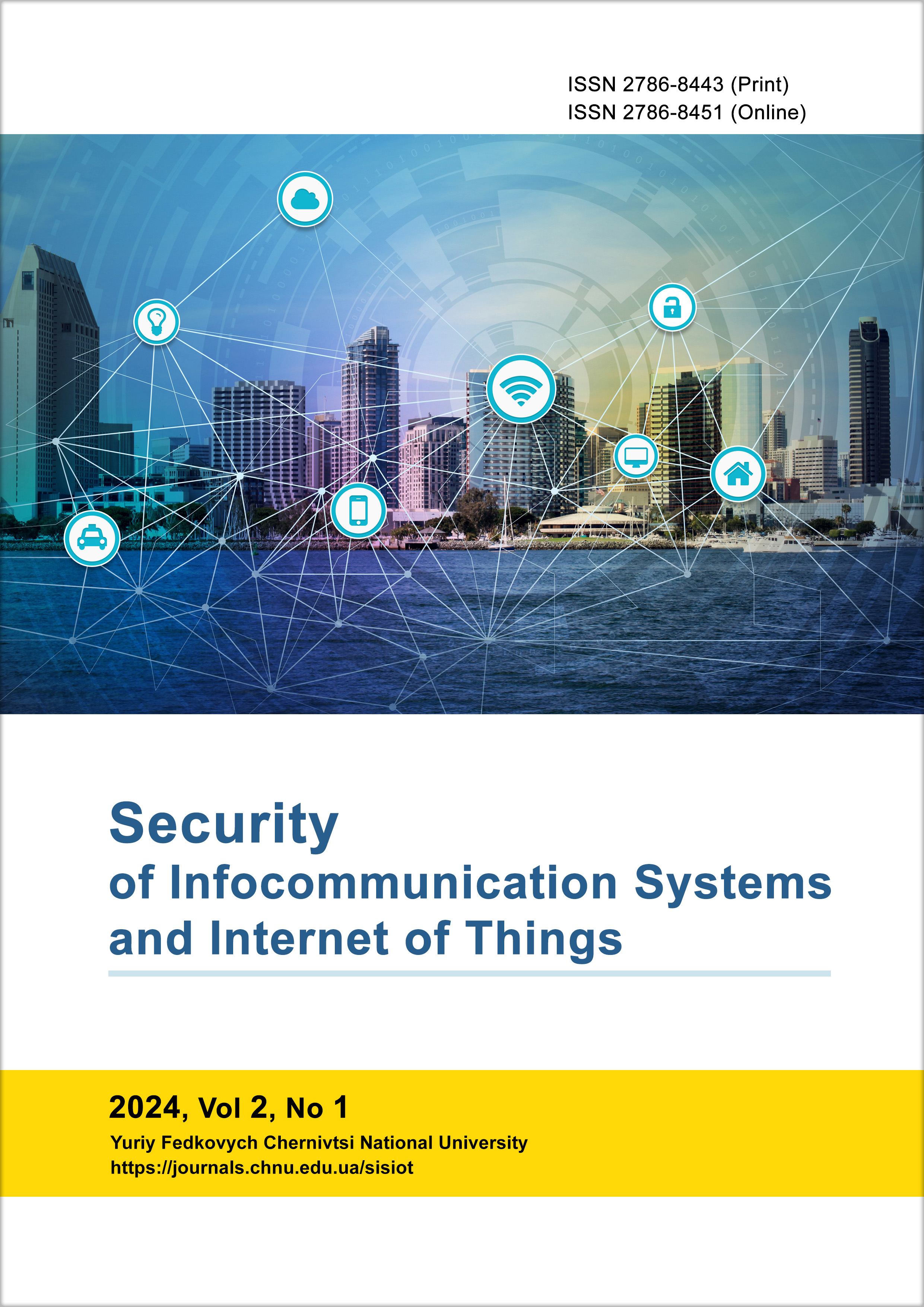Access Control System Based on Ring Resonator’s Sensitive Properties
DOI:
https://doi.org/10.31861/sisiot2024.1.01012Keywords:
ring resonator, transmission line, security, keyspace, access controlAbstract
The paper is dedicated to the development of a new type of electromagnetic (EM) devices to achieve unique output signal patterns for their potential applications in secure systems. The proposed device involves modification of a microstrip transmission line modification by ring resonators. The ring resonator is an EM component that is characterized by high sensitivity, impedance of which can be easily adjusted by its shape changing. It was performed with the ring resonator’s microstrip lines lengthening from 1 to 13.5 mm that allows the resonance frequency changing from 1 to 1.6 GHz, demonstrating the tunability of the device. The modification of a microstrip transmission line with one or a few of such ring resonators by their strong near-field coupling leads to a deep minimum/minima appearance in the transmission line transfer function (S21-parameters spectrum). This minimum can disappear under direct touching of the ring resonator by a human finger – changing of the total capacitance of the ring resonator. It means that the consequence touching/untouching of the ring resonator leads to a modulation of the input transmission line signal and producing unique output signal patterns. As the number of ring resonators increases, the complexity of these patterns also increases. The variety of the patterns can be unique and secure; thus, the output signals can serve as a key for creation of password for systems of access control. To ensure that the security level provided by the device meets the necessary standards, the keyspace – the total number of possible unique patterns – was estimated for various combinations of the developed ring resonators. The analysis revealed that with 14 available ring resonators, the keyspace can exceed 1015, indicating a vast number of possible combinations and, therefore, a very high level of security.
Downloads
References
J. García-García, F. Martín, J. D. Baena, R. Marqués, and L. Jelinek, “On the resonances and polarizabilities of split ring resonators,” J. Appl. Phys., vol. 98, no. 3, p. 033103, 2005.
D. Dobrykh et al., “3D genetic metamaterials for scattering maximization,” arXiv [physics.app-ph], 2024.
J. D. Baena et al., “Equivalent-circuit models for split-ring resonators and complementary split-ring resonators coupled to planar transmission lines,” IEEE Trans. Microw. Theory Tech., vol. 53, no. 4, pp. 1451–1461, 2005.
L. J. Roglá, J. Carbonell, and V. E. Boria, “Study of equivalent circuits for open-ring and split-ring resonators in coplanar waveguide technology,” IET Microw. Antennas Propag., vol. 1, no. 1, p. 170, 2007.
W. N. Hardy and L. A. Whitehead, “Split-ring resonator for use in magnetic resonance from 200–2000 MHz,” Rev. Sci. Instrum., vol. 52, no. 2, pp. 213–216, 1981.
K. Aydin, I. Bulu, K. Guven, M. Kafesaki, C. M. Soukoulis, and E. Ozbay, “Investigation of magnetic resonances for different split-ring resonator parameters and designs,” New J. Phys., vol. 7, pp. 168–168, 2005.
J. Zhou, T. Koschny, M. Kafesaki, E. N. Economou, J. B. Pendry, and C. M. Soukoulis, “Saturation of the magnetic response of split-ring resonators at optical frequencies,” Phys. Rev. Lett., vol. 95, no. 22, p. 223902, 2005.
I. Al-Naib et al., “Conductive coupling of split ring resonators: a path to THz metamaterials with ultrasharp resonances,” Phys. Rev. Lett., vol. 112, no. 18, p. 183903, 2014.
F. Aznar, A. Vélez, M. Durán-Sindreu, J. Bonache, and F. Martín, “Open complementary split ring resonators: Physics, modelling, and analysis,” Microw. Opt. Technol. Lett., vol. 52, no. 7, pp. 1520–1526, 2010.
C.-S. Lee, B. Bai, Q.-R. Song, Z.-Q. Wang, and G.-F. Li, “Open complementary split-ring resonator sensor for dropping-based liquid dielectric characterization,” IEEE Sens. J., vol. 19, no. 24, pp. 11880–11890, 2019.
S.-Y. Jang and J.-R. Yang, “Double split-ring resonator for dielectric constant measurement of solids and liquids,” J Electromagn Eng Sci, vol. 22, no. 2, pp. 122–128, 2022.
M. Puentes, M. Maasch, M. Schubler, and R. Jakoby, “Frequency multiplexed 2-dimensional sensor array based on split-ring resonators for organic tissue analysis,” IEEE Trans. Microw. Theory Tech., vol. 60, no. 6, pp. 1720–1727, 2012.
C. Reimann et al., “Planar microwave sensor for theranostic therapy of organic tissue based on oval Split Ring Resonators,” Sensors (Basel), vol. 16, no. 9, p. 1450, 2016.
S. P. Chakyar, S. K. Simon, C. Bindu, J. Andrews, and V. P. Joseph, “Complex permittivity measurement using metamaterial split ring resonators,” J. Appl. Phys., vol. 121, no. 5, p. 054101, 2017.
K. Xu et al., “Novel microwave sensors based on split ring resonators for measuring permittivity,” IEEE Access, vol. 6, pp. 26111–26120, 2018.
K. Grotov, A. Mikhailovskaya, D. Vovchuk, D. Dobrykh, C. Rockstuhl, and P. Ginzburg, “Superradiant broadband magneto-electric arrays empowered by meta-learning,” arXiv [physics.app-ph], 2023.
A. M. Albishi, S. A. Alshebeili, and O. M. Ramahi, “Three-dimensional split-ring resonators-based sensors for fluid detection,” IEEE Sens. J., vol. 21, no. 7, pp. 9138–9147, 2021.
A. Ebrahimi, J. Scott, and K. Ghorbani, “Differential sensors using microstrip lines loaded with two split-ring resonators,” IEEE Sens. J., vol. 18, no. 14, pp. 5786–5793, 2018.
D. Vovchuk, M. Khobzei, and M. Khavruniak, “Sensing properties of SRR: Influence of finger touching,” in 2019 IEEE International Scientific-Practical Conference Problems of Infocommunications, Science and Technology (PIC S&T), 2019.
X. Hu and W. Yang, “Planar capacitive sensors – designs and applications,” Sens. Rev., vol. 30, no. 1, pp. 24–39, 2010.
Published
Issue
Section
License
Copyright (c) 2024 Security of Infocommunication Systems and Internet of Things

This work is licensed under a Creative Commons Attribution 4.0 International License.









